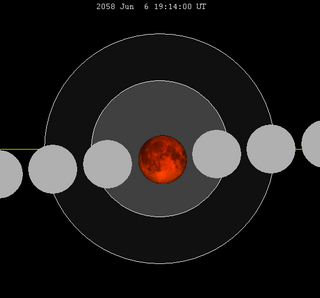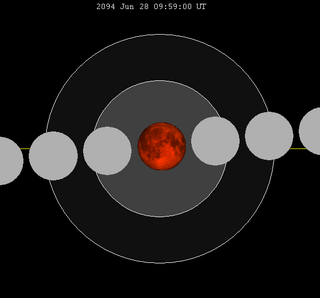| Partial eclipse | |||||||||||||
| Date | March 12, 1914 | ||||||||||||
|---|---|---|---|---|---|---|---|---|---|---|---|---|---|
| Gamma | -0.5254 | ||||||||||||
| Magnitude | 0.9111 | ||||||||||||
| Saros cycle | 131 (28 of 72) | ||||||||||||
| Partiality | 181 minutes and 29 seconds | ||||||||||||
| Penumbral | 301 minutes and 28 seconds | ||||||||||||
| |||||||||||||
A partial lunar eclipse took place on Thursday, March 12, 1914.
Lunar Saros series 131, has 72 lunar eclipses. Solar Saros 138 interleaves with this lunar saros with an event occurring every 9 years 5 days alternating between each saros series.
This eclipse series began in AD 1427 with a partial eclipse at the southern edge of the Earth's shadow when the Moon was close to its descending node. Each successive Saros cycle, the Moon's orbital path is shifted northward with respect to the Earth's shadow, with the first total eclipse occurring in 1950. For the following 252 years, total eclipses occur, with the central eclipse being predicted to occur in 2078. The first partial eclipse after this is predicted to occur in the year 2220, and the final partial eclipse of the series will occur in 2707. The total lifetime of the lunar Saros series 131 is 1280 years. Solar Saros 138 interleaves with this lunar saros with an event occurring every 9 years 5 days alternating between each saros series.
Because of the ⅓ fraction of days in a Saros cycle, the visibility of each eclipse will differ for an observer at a given fixed locale. For the lunar Saros series 131, the first total eclipse of 1950 had its best visibility for viewers in Eastern Europe and the Middle East because mid-eclipse was at 20:44 UT. The following eclipse in the series occurred approximately 8 hours later in the day with mid-eclipse at 4:47 UT, and was best seen from North America and South America. The third total eclipse occurred approximately 8 hours later in the day than the second eclipse with mid-eclipse at 12:43 UT, and had its best visibility for viewers in the Western Pacific, East Asia, Australia and New Zealand. This cycle of visibility repeats from the initiation to termination of the series, with minor variations. Solar Saros 138 interleaves with this lunar saros with an event occurring every 9 years 5 days alternating between each saros series.
Lunar Saros series 131, repeating every 18 years and 11 days, has a total of 72 lunar eclipse events including 57 umbral lunar eclipses (42 partial lunar eclipses and 15 total lunar eclipses). Solar Saros 138 interleaves with this lunar saros with an event occurring every 9 years 5 days alternating between each saros series.
| Greatest | First | |||
|---|---|---|---|---|
 The greatest eclipse of the series will occur on 2094 Jun 28, lasting 102 minutes. [1] | Penumbral | Partial | Total | Central |
| 1427 May 10 | 1553 July 25 | 1950 Apr 2 | 2022 May 16 | |
| Last | ||||
| Central | Total | Partial | Penumbral | |
| 2148 Jul 31 | 2202 Sep 3 | 2563 Apr 9 | 2707 Jul 7 | |
| 1914 Mar 12 | 1932 Mar 22 | 1950 Apr 2 | |||
 |  |  |  |  |  |
| 1968 Apr 13 | 1986 Apr 24 | 2004 May 4 | |||
 |  |  |  |  |  |
| 2022 May 16 | 2040 May 26 | 2058 Jun 6 | |||
 |  |  |  |  |  |
| 2076 Jun 17 | 2094 Jun 28 | ||||
 |  |  |  | ||
A lunar eclipse will be preceded and followed by solar eclipses by 9 years and 5.5 days (a half saros). [2] This lunar eclipse is related to two annular solar eclipses of Solar Saros 138.
| March 6, 1905 | March 17, 1923 |
|---|---|
 |  |
The saros is a period of exactly 223 synodic months, approximately 6585.3211 days, or 18 years, 10, 11, or 12 days, and 8 hours, that can be used to predict eclipses of the Sun and Moon. One saros period after an eclipse, the Sun, Earth, and Moon return to approximately the same relative geometry, a near straight line, and a nearly identical eclipse will occur, in what is referred to as an eclipse cycle. A sar is one half of a saros.

A total lunar eclipse took place on November 9, 2003, the second of two total lunar eclipses in 2003, the first being on May 16, 2003. It is the first total lunar eclipse of 21st century which happened in a micromoon day.

A total lunar eclipse took place on May 4, 2004, the first of two total lunar eclipses in 2004, the second being on October 28, 2004.

A total lunar eclipse took place on October 27-28, 2004, the second of two total lunar eclipses in 2004, the first being on May 4, 2004. It was the first lunar eclipse to take place during a World Series game, which when seen from Busch Memorial Stadium in St, Louis, Missouri, provided a surreal sight on the night the Boston Red Sox won their first World Series in 86 years to end the Curse of the Bambino. Occurring 5.6 days before apogee, the Moon's apparent diameter was smaller. The moon was 10.1 days after perigee and 5.6 days before apogee.

A total lunar eclipse took place at 0308 UT (GMT) on Thursday, August 17, 1989, the second of two total lunar eclipses in 1989.

A total lunar eclipse will take place on May 26, 2040. The northern tip of the moon will pass through the center of the Earth's shadow. This is the second central lunar eclipse of Saros series 131.
A total lunar eclipse will take place on 16 May 2022, the first of two total lunar eclipses in 2022. A second eclipse will happen on 8 November.

A total lunar eclipse took place on Thursday, April 24, 1986, the first of two total lunar eclipses in 1986, the second being on October 17, 1986.
A total lunar eclipse will take place on Sunday, September 7, 2025. The Moon will barely miss the center of the Earth's shadow.

A total lunar eclipse took place on Saturday, April 13, 1968, the first of two total eclipses in 1968, the second being on October 6, 1968.

A total lunar eclipse took place on Sunday, April 2, 1950. This was the first total lunar eclipse of Saros cycle 131.

A total lunar eclipse will take place on June 6, 2058. The moon will pass through the center of the Earth's shadow.

A total lunar eclipse will take place on June 17, 2076. The moon will pass through the center of the Earth's shadow. While the visual effect of a total eclipse is variable, the Moon may be stained a deep orange or red color at maximum eclipse. With a gamma value of only -0.0452 and an umbral eclipse magnitude of 1.7943, this is the second greatest eclipse in Saros series 131 as well as the largest and darkest lunar eclipse between June 26, 2029 and June 28, 2094. Overall, it will be the third largest and darkest lunar eclipse of the 21st century. While it will have similar values to the lunar eclipse of July 16, 2000, totality will not last over 106 minutes due to the moon's relatively large apparent size as seen from Earth and greater speed in its elliptical orbit. Totality's expected to last 100 minutes 34 seconds from 9:11:39 to 10:52:15 with the greatest point at 10:01:57 UTC.

A total lunar eclipse will take place on June 28, 2094. The moon will pass through the center of the Earth's shadow. While the visual effect of a total eclipse is variable, the Moon may be stained a deep orange or red color at maximum eclipse. With a gamma value of only 0.0288 and an umbral eclipse magnitude of 1.8234, this is the greatest eclipse in Saros series 131 as well as the second largest and darkest lunar eclipse of the 21st century.

A partial lunar eclipse took place on Tuesday, March 22, 1932. This nearly total lunar eclipse of Saros cycle 131 preceded the first total eclipse on April 2, 1950.

A total lunar eclipse will take place on September 19, 2043.
Saros cycle series 128 for lunar eclipses occurs at the moon's ascending node, repeating every 18 years 11 and 1/3 days. It contains 71 events. Solar saros 135 interleaves with this lunar saros with an event occurring every 9 years 5 days alternating between each saros series.
Saros cycle series 130 for lunar eclipses occurs at the moon's ascending node, 18 years 11 and 1/3 days. It contains 71 events. Solar saros 137 interleaves with this lunar saros with an event occurring every 9 years 5 days alternating between each saros series.
Saros cycle series 127 for lunar eclipses occurs at the moon's descending node, repeats every 18 years 11 and 1/3 days. It contains 72 events. Solar saros 134 interleaves with this lunar saros with an event occurring every 9 years 5 days alternating between each saros series. It consisted with 10 penumbral eclipses, 21 partial eclipses, 11 total eclipses, 21 partial eclipses, and ends with 8 penumbral eclipses.

A penumbral lunar eclipse will occur on November 8, 2060. It will be too small to be visually perceptible.